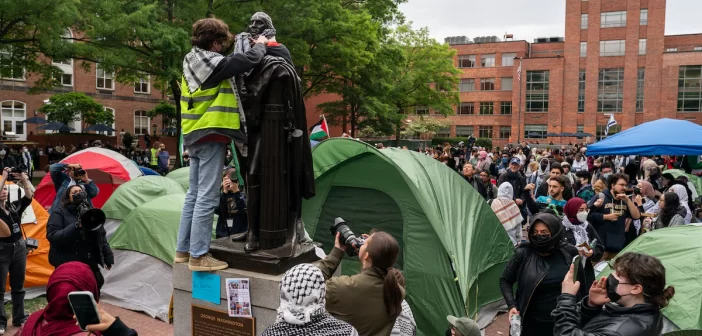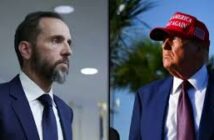D.C. police rejected pleas from George Washington University officials to clear pro-Palestinian demonstrators out of an on-campus encampment early Friday morning, saying they worried about the optics of moving against a small number of peaceful protesters, according to two officials familiar with the talks.Officers had assembled around 3 a.m. and were prepared to enter the encampment, but senior leaders in the police chief’s and mayor’s office ordered them to stand down, the officials said. The demonstrators were small in number and largely peaceful, and the city officials told their university counterparts they wanted to avoid images of violent altercations between police and protesters flashing across TV screens across the country. The George Washington campus is just west of downtown Washington, five blocks from the White House.
As of Friday night, D.C. police had not sought to arrest anyone in the encampment, though university officials surrounded it with barricades and were not allowing new people to join. The city officials, who spoke on the condition of anonymity to discuss sensitive police operations, said they had no immediate plans to clear the area known as University Yard along H Street between 20th and 21st streets NW. They noted that could change if the demonstrators began committing or advocating violence, or if radical groups joined the group’s ranks.A spokeswoman for George Washington University did not answer questions about school officials’ discussions with law enforcement authorities. The school said in a statement, “After demonstrators refused multiple instructions to relocate, GWPD requested additional support from the DC Metropolitan Police to ensure the safety and security of all our community members through a measured and orderly approach.”
D.C. police also declined to comment on agency officials’ discussions with the university, and it was not immediately clear what tactics they considered using as officers prepared to enter the encampment Friday morning. D.C. police are accustomed to dealing with daily demonstrations over all manner of political issues in the nation’s capital, and they typically try to convince demonstrators to voluntarily surrender. But they can also use more aggressive tactics, donning riot gear, forming lines and forcefully trying to move large groups.
A statement from a D.C. police spokesman said officers have been monitoring the demonstration. Thus far, D.C. police have kept up a low-key presence near the protest sight.As always, we are continually assessing and evaluating the circumstances on the ground to inform our response,” the statement said.
Chuck Wexler, the executive director of the Police Executive Research Forum, which advises law enforcement agencies on best practices, said it is rare that an agency would turn down a request from a university to clear unwanted demonstrators from its campus, which is private property. At protests over the war in Gaza on other college campuses, police have sometimes sparred with demonstrators as they have sought to make arrests and break up encampments.
But Wexler said the university should demonstrate to police “a compelling reason” for them to intervene, and D.C. police appeared to be taking a wait-and-see approach.If these are peaceful demonstrators and MPD says, ‘Look, we’ll stand by. We’re not leaving, we’re simply saying at this moment we don’t see a compelling need to come in,’ then that’s okay,” he said.
In Boston, law enforcement officers moved in on pro-Palestinian demonstrators attempting to form a human wall. The exchange was so tense that police reported at least four injured officers, and multiple students at Emerson College said they were shoved to the ground.
In Southern California, law enforcement officers looking to break up an on-campus tent encampment pushed through a growing crowd, struggled with protesters and ultimately arrested more than 90 of them.Atlanta police said officers used chemical irritants when they faced off with demonstrators at an encampment at Emory University. And in Texas, state troopers dressed in riot gear took dozens of protesters into custody at the direction of Gov. Greg Abbott (R). Some troopers marched through campus on horseback. Others set up a barricade by pushing demonstrators with their bikes.
In D.C., the protesters are on private university property, and absent seeing a crime being committed, D.C. police said they need to be invited to take action on the campus. To do that, school officials would have to declare the demonstrators illegal trespassers who refuse to leave, or cite other possible crimes.
The D.C. officials who described the decision not to break up the George Washington University encampment said they had flashbacks to June 2020, when images of mostly peaceful protesters being forcefully shoved out of Lafayette Square by Park Police officers with batons and chemical irritants made national news. The officials said city leaders suggested alternatives to force an end the demonstration at George Washington University, but they did not describe what those were.By late afternoon Friday, the number of demonstrators in the encampment had dwindled to about three dozen. The university then warned students who remain in the encampment they could face temporary suspension or be administratively barred from campus.
In a statement, Arielle Geismar, the student government association president, said she urged the administration “not to use violence or actionable force by asking either [university police]or [D.C. police] to forcibly remove students.”Geismar said that “students across the country have been brutalized and hurt during forced removals. I’m extremely worried about student safety.” She said school leaders have not briefed her on their plans.
D.C. police rejected GWU’s plea to sweep out university protesters
Share



